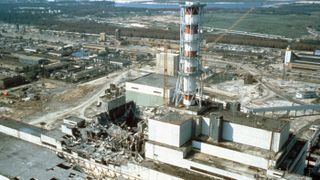
- Chernobyl episode 3 summary drivers#
- Chernobyl episode 3 summary full#
- Chernobyl episode 3 summary series#
This nucleus is unstable and decays with a half-life of 6.6 hours to xenon-135, which itself has a "natural" half-life of 9.1 hours. The energy release comes from the fact that the mass of the products is less than the mass of reactants.) About 6.5% of the fission events produce iodine-135. uranium-235) and a neutron combine, producing two smaller nuclei and a few free neutrons while releasing a lot of energy. In nuclear fission, a heavy nucleus (i.e. In any analogy, k > 1 cannot go on forever. Consider it this way: k is the amount of fission at one time, compared to what it was an instant before. So, k = 1 means that the fission rate is constant, less than 1 means the rate is spiraling down, and greater than 1 means it is increasing. This is where the term "chain reaction" comes from. Neutrons both initiate fission and are generated by fission.

Chernobyl episode 3 summary drivers#
(HBO)Īs explained in episode 5 of Chernobyl, "Vichnaya Pamyat" (Ukrainian for "memory eternal"), there are positive (red cards) and negative (blue cards) drivers of reactor "reactivity." Think of this reactivity, call it "k," as the change in the energy released in the fission process with time.

Jared Harris as Valery Legasov describes the positive (red cards) and negative (blue cards) drivers of reactivity.
Chernobyl episode 3 summary full#
While no short presentation can do justice to the accident, HBO’s depiction of the reactor failure was masterfully done. To nuclear scientists, the idea that you could take a reactor that had been running at normal power, reduce it to an idling power level, and then bring it back up to full power, is foolish and known to be so from experience gained in the early 1940s from the Hanford, WA reactor that produced plutonium for the Manhattan Project. This essay offers a commentary on the HBO series, intended for those who watched all five episodes, focusing on the technical aspects but broaching the subject of how humans and societies construe nuclear technology.
Chernobyl episode 3 summary series#
The creators of this series were not afraid of technical scientific details, as they realized the story had a scientific core wrapped in how humans, as well as the Soviet bureaucracy, responded to complex truths, both politically troublesome and culturally traumatic. Today, Chernobyl remains a cultural touchstone for the dangers of nuclear technology, serving as a comparison for any nuclear accident.Ī popular HBO series, Chernobyl, was aired this summer detailing, and dramatizing, what happened.

There was a run on iodine pills and a dramatic increase in elective abortions. The reports from the USSR were not informative, but fission products (ash from the nuclear fission process) were being reported in air samples throughout Europe. The newest reactor (#4) at the Chernobyl site exploded, 50 miles north of Kiev in the Ukraine and only a few miles from the border with Belarus. Those of us of a certain age remember that the world shook on April 26, 1986.


 0 kommentar(er)
0 kommentar(er)
